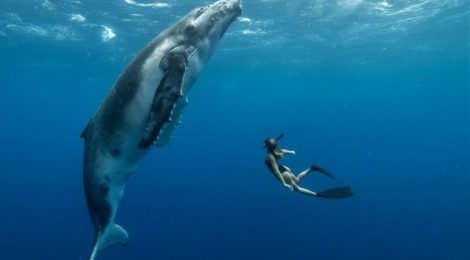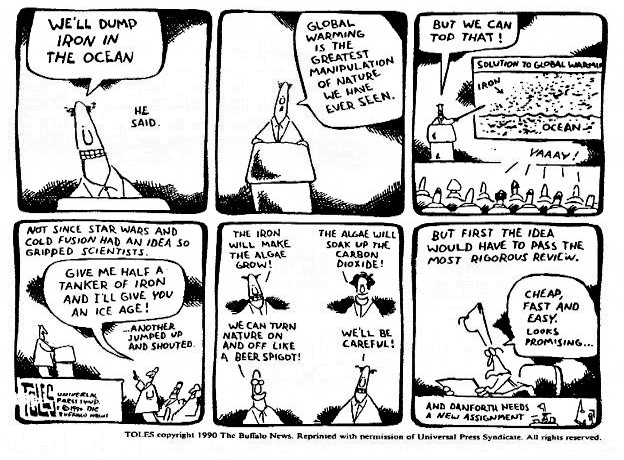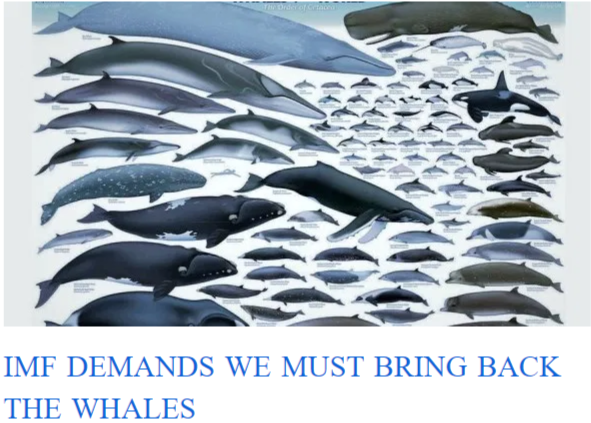
Ocean Iron And Plankton, Changes In Latitudes Changes in Attitudes
30 Years Ago Late Great Oceanographer John Martin Reported Ocean Plankton Have Always Controlled Our Climate
If Martin’s ‘Geritol Hypothesis’ was correct, the cure for climate change was/is at hand
Now ‘real science in low latitudes’ reported in the Journal Nature reaffirms John Martin’s ideas,
But will it change ‘politically motivated science’ attitudes?
A new paper in the Journal Nature has added ammunition to finally settle a decades-long argument by proving that the dust that blows from the land, recently in deadly decline, controls ocean pasture plankton productivity at all latitudes. Those ocean pastures and their power to take CO2 out of the atmosphere, in turn, control the global climate. It’s now clear that ocean change creates climate change, it’s a vicious circle. More grass growing means less dust blowing, and that means less plankton.
This story began almost 30 years ago when Professor John Martin, who headed California’s top ocean science research lab at Moss Landing, revealed in his magnum opus paper that showed ocean plankton were in control of planetary CO2. Those ocean plankton and whale pastures, regardless of latitudes, he showed were in turn, controlled by iron carried to the ocean pastures by dust in the wind. What has been 30 years of fruitless argument and bad attitudes began. Precious decades have been lost which might have already saved the world from dire climate change impacts had his incredibly simple ideas been implemented.
Changes in Latitudes

NASA maintains a special tribute page for John Martin titled: ON THE SHOULDERS OF GIANTS. His work is today remembered once again for its incite and intellect. – Click to read more
One fair scientific question that some thought might have merit and run contrary to Martin’s phytoplankton global potency was the nature of plankton ecology/chemistry in the world’s low latitude oceans. Everyone agreed plankton blooms in the high latitudes behaved as Martin described, but the lower latitudes (between 40N and 40S) that was available for argument.
The controversy has been rigorous and as such few scientists deigned or dared to dive into the lower latitude phyto-iron ecology. But now in a great work published in the Journal Nature titled, Solution to Decades-Old Puzzle of Ice Age Ocean Chemistry, John’s scientist shipmates stand before the mast testifying in support of John Martin’s life’s work.
Importantly also just now the International Monetary Fund has called for the restoration of whales as they calculate the whales that feed in ocean plankton pastures are worth more than a trillion dollars as a natural climate change mitigation technology. To bring back the whales one must bring their ocean pastures to historic levels of health and abundance.
Data Speaks Convincingly
New research into the chemistry of the oceans during ice ages has been helping to solve a puzzle that has engaged scientists for three decades. The debate, political science, has been over how much of the CO2 that entered the ocean during ice ages can be attributed to the “biological pump,” where atmospheric carbon is absorbed by phytoplankton and sequestered to the deep ocean by biological means.
In the paper the researchers report that today, phytoplankton that inhabit high latitude regions are unable to consume all available
macronutrients, which allows CO2 to escape to the atmosphere. Further
“The beauty of this approach is that it can explain almost all of the additional CO2 that phytoplankton transported into the oceans during the last Ice Age,” said Prof. Chase, a member of the research project. “The increased activity of the biological pump in the tropics complemented that happening in colder waters, drawing higher levels of CO2 into the oceans and locking it away in the deep ocean.”
One vital message they clearly state in their report is “The pathway for carbon to the deep ocean is reduced today because less fertilizing iron is being circulated by the wind — phytoplankton growth, including that of nitrogen fixers, is correspondingly limited.

John Martin’s 1990 Plankton Controls the Climate – Boston Globe Political Cartoon – Click to enlarge
Solving the puzzle is vitally important to improve the accuracy of climate models and inform understanding of how ocean processes are reacting to present and future climate change.
Tasman IMAS scientists and University of Liverpool scientists and published today (October 10, 2019) in Nature Communications, the study reports that irrefutable data shows that ice age phytoplankton in the tropics in fact absorbed and sequestered vast amounts of CO2 due to fertilization by iron-rich dust blowing into the ocean. The cold ‘ice age’ was a time when insufficient CO2 was in the atmosphere acting as a greenhouse gas blanket keeping our blue planet warm. It was the ocean plankton that had pulled the warm CO2 blanket too far down.
Lead author Dr. Pearse Buchanan said that until now models had only been able to explain a portion of the CO2 that entered ice age oceans via the biological pump, but here he sets the record straight:
“During past ice ages, carbon levels were lower in the atmosphere and higher in the oceans than today, but scientific models aren’t able to account for all of the additional CO2 that entered the ocean.”
“The leading hypothesis has been that iron-rich dust blown from glacial landscapes stimulated phytoplankton growth in high latitudes, but this only explained around one-third of the extra CO2 absorbed through the biological pump: the other two-thirds was effectively “missing.”
“We used an ocean model to look at the response to iron-rich dust of phytoplankton in tropical waters, particularly a group of phytoplankton called “nitrogen fixers.”
“These are able to biochemically “fix” nitrogen from the atmosphere, much like nitrogen-fixing bacteria that help legume crops thrive in nutrient-poor soil.
“Marine nitrogen fixers are known to be important in the marine nitrogen cycle, and now we’ve shown they’re also critically important in the marine carbon cycle.
“When we added iron to our ocean model, nitrogen fixers thrived, and their growth and subsequent sinking to the deep ocean can account for much of the missing CO2.”
To every thing there is a season, and a time to every purpose under the heaven:
A time to be born, and a time to die; a time to plant, a time to reap that which is planted;
The time has come for humanity to begin to act as responsible ocean pasture stewards. Ten thousand years ago we took up the role as good shepherds to pastures on land so that the wildlife and livestock living on those pastures would thrive as healthy sustainable herds. It was the beginning of modern agricultural practice.
Humanities treatment of our ocean pastures has never been more than to treat them as endless wild and lawless places where all could go to capture and kill with abandon and never give back. With the proof positive now in hand, we can, and must, begin to not only care for our ocean pastures but to restore them to historic levels of health and abundance. As we do so those pastures and their livestock, the whales, fish, seabirds, and plankton will, in turn, take care of us and the climate.
Everywhere on this blog you may read about how we have proven we can restore the health of the oceans. Join me.
Reference: “Marine nitrogen fixers mediate a low latitude pathway for atmospheric CO2 drawdown” by Pearse J. Buchanan, Zanna Chase, Richard J. Matear, Steven J. Phipps and Nathaniel L. Bindoff, 10 October 2019, Nature Communications.
DOI: 10.1038/s41467-019-12549-z









